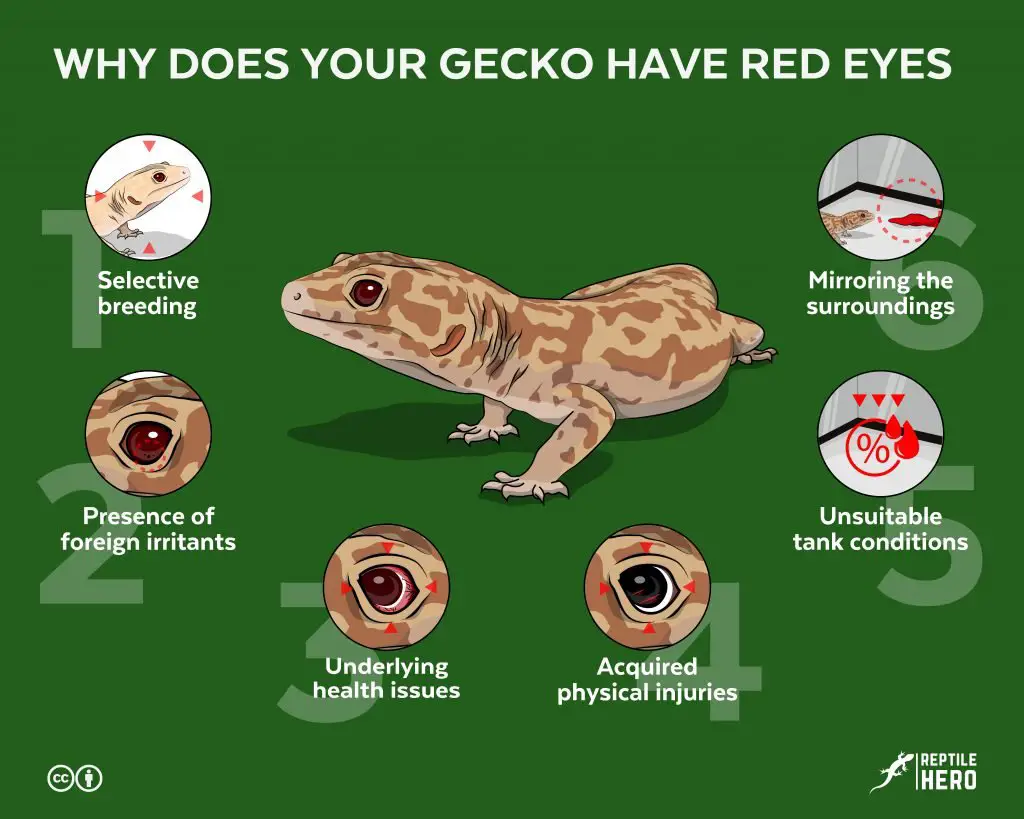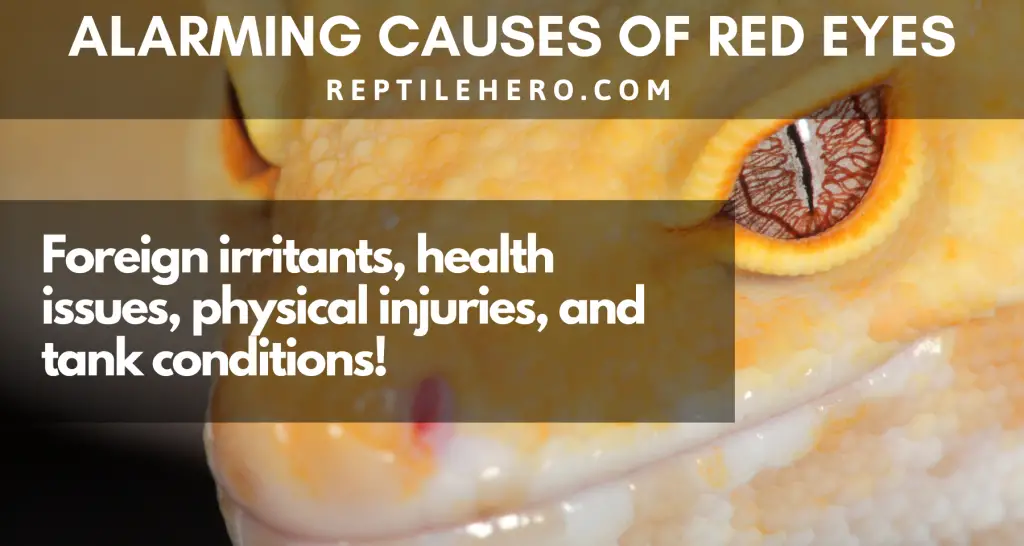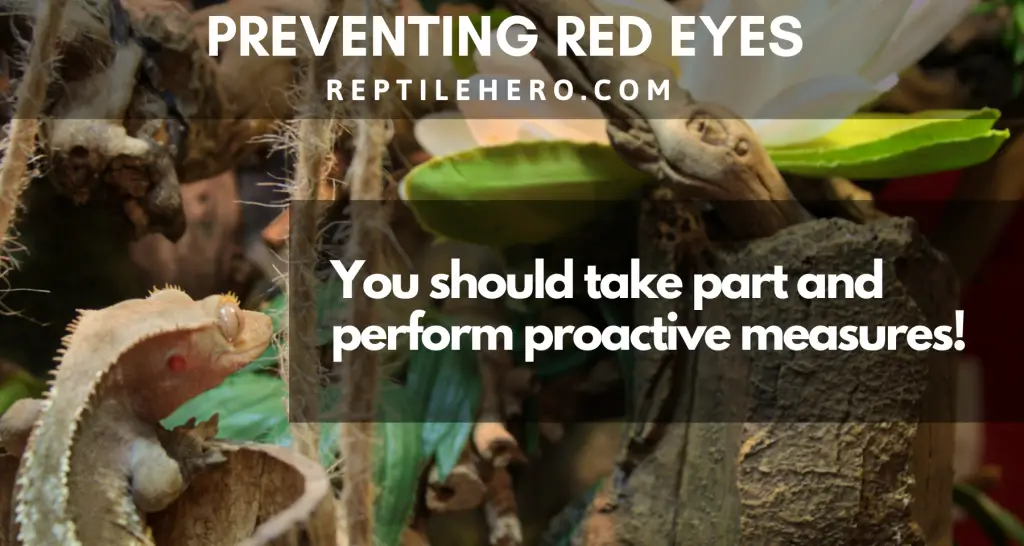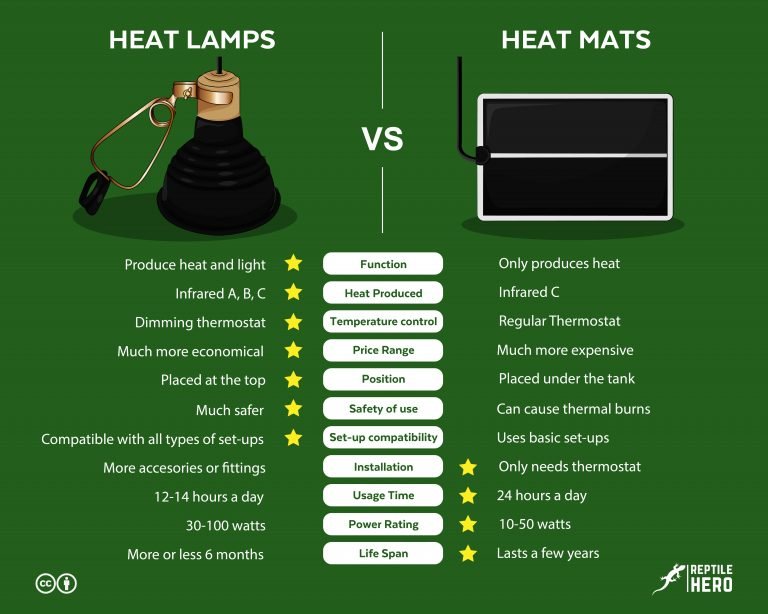Why Does Your Gecko Have Red Eyes? [6 Reasons]
Have you chosen your leopard or crested geckos because of their large, round eyes that make them very adorable pets? These skeptic-looking reptiles may be cute; however, their eyes are prone to natural and external-induced redness.
Red eyes in geckos could be due to six common causes: 1) selective breeding, 2) presence of foreign irritants, 3) underlying health issues, 4) acquired physical injuries, 5) unsuitable tank conditions, and 6) mirroring the surroundings.
Keep on scrolling to know the reasons for your dilemma.
6 Causes of Gecko Red Eyes
Before we enumerate some possible reasons contributing to your gecko’s red eyes, let us first have a quick recap of its eyes.
Overview of Gecko Eyes
Leopard geckos have a strange proportion of their eyes. When you look closely, you will notice how enormous their eyes are at the side of their head. Moreover, you would undoubtedly have seen a bump surrounding the eyes, have you not? These are eyelids.
How many times have you noticed them cleaning their eyes by licking the eyeballs? Do not worry! This is a natural behavior like how we rub our eyes to comfort ourselves from discomfort.
On the other hand, crested geckos do not have eyelids. They share the same fate with leopard geckos of having a large pair of round eyes on the side of their head. Though you would not see it even if you stare closely at them, they have a transparent protective scale to cover each eye. This layer keeps both of their eyes moist.
If you observe them licking their eyes with their tongues like how leopard geckos would, you have nothing to worry about. Though they have those thin layers, they still need to periodically lick their eyes to keep them free from debris.
With their distinct evolutionary paths, both leopard and crested geckos still frequently experience eye redness along with other eye-related problems—may it be caused by natural reasons or not. Hence, you should be vigilant in assessing such occurrences to your pet. In this way, you can appropriately provide care and relief prior to scheduling an appointment for professional help.

Let us check out the six reasons why your gecko’s eyes are red.
1. Genetic Origins
Even though I am only a gecko hobbyist, one of my expert breeder friends was kind enough to explain why leopard geckos could have red eyes without any interventions from external factors or their environment.
In captivity, leopard geckos could potentially acquire red-eye traits via selective breeding. Only two out of the many breeding permutations are viable to express the said trait.
Hence, you can deduce that red-eyed geckos could be a product of any of the two reproductions:
- A homozygous Bell albino and a heterozygous or homozygous Enigma will produce offspring with red eyes. However, the redness will not have total coverage on the eyes (not solid red).
- A homozygous Eclipse and a homozygous albino of any strain will produce offspring with some Eclipse features. When the eye pigment amount is 100%, the eyes would be a solid ruby (solid red) in color.
Although hobbyists and experts widely use “albinism” and “albino” in leopard gecko morphs, it is better to inform you ahead that those names could be misleading.
Reptiles—including leopard geckos—often possess at least two pigments in their bodies. Hence, strictly speaking, no true albinos exist in leopard geckos when albino definition refers to the complete absence of all color pigments [1].
Instead, they are extreme amenalistics. This means that they have tyrosinase enzymes capable of producing melanin, however, at very little to no amount. Hence, you could still see orange, yellow, and brown leopard gecko albinos because only the production of melanin pigmentation is affected while other pigments’ creation still continues.
What About An “Albino” Crested Gecko?
Successful selective breeding of albino traits in leopard geckos has brought a unique red-eye characteristic to the species. However, “albino” crested geckos with red eyes have not yet been found.
Although previous speculations of an “albino” hatchling in the past, its status is undetermined since it died after a few days of hatching. Furthermore, light-colored Crested Geckos are often mislabeled as “albinos” to deceive buyers for profit, so you must be careful.
Hence, if you notice unnaturally bloodshot eyes in your crested geckos, you better keep to find out other possible reasons.
2. Foreign Irritants
Knowing how disproportional the eyes of leopard and crested geckos are compared to their head’s size, this circumstance increases their sensitivity and vulnerability to uninvited foreign objects in the eye area.
These unsolicited particles could come from anything inside the enclosure, such as:
- food matter and waste
- retained skin and shed
- dust and particles from accessories
- plant material like leaves and barks
- substrates like soil, dusty mulch, and peat moss
Since the above do not naturally belong to the gecko’s eyes, entering the area would instantaneously irritate the conjunctiva or the cornea. A bit of biology here: conjunctiva is the pink tissue lining the inner lids around their eyes. Meanwhile, the cornea is a thin layer that directly covers the surface of their eyes.
Once these alien materials lodge, get stuck in the socket of their eyes and go beneath the eyelids in leos, these could risk and commence an infection to your gecko. Aside from the redness of the eyes, some indicative flags that could help you assess the situation include:
- extreme tearing
- crusty discharge
- persistent squinting in leos
Here is a short clip of a crested gecko cleaning its eye from any debris.
3. Health Issues
Though external materials may almost always precede eye-related problems when left untreated, other causes leading to gecko eye infections that manifest red and irritated eyes can be bacterial, parasitic, viral, or deficiency in nature.
Bacterial
One of the bacterial eye infections commonly diagnosed in leopard geckos is conjunctivitis. It is an inflammation of the pink and fleshy tissue surrounding the lids of your gecko’s eyes.
Typically, leos can get their conjunctiva inflamed from dirty water and an unclean environment. As a result of the unsanitary enclosure, bacteria responsible for the infection breed and proliferate in the tank.
Another bacterial eye infection that does not only affect leopard geckos but also crested geckos is uveitis. It is an uncommon eye inflammation affecting the middle layers of tissue in your gecko’s eyes. Aside from your pet’s bloodshot eyes, an infected gecko may show signs of blurry vision. Usually, this infection is associated with other systemic infectious diseases, post hibernation diseases, trauma, and neoplasia.
Parasitic
One exotic veterinarian has claimed that geckos, specifically leos, have exhibited red eyes infected by parasites in rarer cases. He described his observation as “thin, string-type worms in the conjunctival sac of leopard geckos’ eyes.” [2]
Viral
Although its underlying infectious etiology is not yet established, neoplasia in leopard and crested geckos is hypothesized to be viral in origin. It consists of neoplasms—benign or malignant tumors—around the eyelids, with some prevalence resulting in red eyes. This condition is hardly treated even with surgical debulking [3].
Deficiency
Other leopard and crested gecko eye problems may be a result of nutritional deficiency like hypovitaminosis A. An affected gecko may experience trouble shedding its skin. When this worsens, it may cause a buildup of cellular matter under the eyelids until eye irritation occurs and red eyes appear [4].
4. Physical Injuries
If the gecko does not show signs and symptoms of feeling unwell, having red eyes could be because of physical injuries like trauma to the eye in the form of scratches, bites, or abrasions.
Impact Damage
Does your gecko jump around a lot for fun? Or is it skittish and nervous that flail inside the tank once in a while? It may have bumped against or collided into something in its enclosure.
Physical damages in geckos caused by their actions can result in mild abrasions from rubbing on surfaces to lacerations that may heal independently. Either way, if their eyes have received significant impacts, the fragile blood vessels and engorged veins could burst.
When this happens, blood may erupt under the eyes’ outer surface, resulting in a bloodshot. Typically, this situation just clears up and goes back to normal within two to three days without seeking professional help.
Light Burns
Although gecko owners like you take utmost precaution and care in protecting your pet from all possible physical injuries, accidents can still happen. Even getting distracted for a split of seconds and missing out on minute husbandry may lead to eye burns.
For crepuscular geckos like leopards and crested that are most active at twilight periods, their eyes are reckoned more sensitive to and can be burned by excess UVB and UVC exposure. The burnt eyes could physically manifest as red and irritated.
Eye burns, along with other burns, are usually associated with various kinds of heat sources. Some of the common ones like under-tank heating (UTH) pads and overhead lights are deemed required in the enclosure as you know it.
Although these heat sources offer to aid in your gecko’s thermoregulation, they could also pose a burn hazard as your reptile gets closer to them. Often, burns also occur as a result of:
- utilizing heat rocks as a source
- lack of substrate to buffer UTHs
- improper placement of heating elements
- use of non-thermostat-controlled sources
5. Tank Conditions
While the sanitation of their enclosure may comprise more than half of the reasons why leopard and crested geckos have red eyes, the tank conditions could also contribute to such an unpleasant incident.
When the required tank humidity levels of 30–40% for leopard geckos and 60–80% for crested geckos are not consistently met, they may experience poor shedding. The retained shed in the eye area could irritate the eyes, causing these to redden.
Unfortunately, several gecko owners do not immediately notice this occurring until the reptile has completely stopped eating and has considerably lost weight. You should be watchful to prevent further and more severe eye damage.
Meanwhile, failure to maintain the correct temperature needs from 64 to 78°F and consistent exposure to temperatures above 85°F can lead to bloodshot eyes in crested geckos, preceding heat stroke.
Knowing that crested geckos cannot blink to moisten their eyes, you need to know that high temperatures elevate the risk of quickly drying their eyes out, causing the blood veins to engorge and appear redder. Lowering the temperature by misting can temporarily alleviate the issue.

6. Surroundings
As you love to stare at your gecko’s eyes, you may as well be proficient by now how vast and immense its eyes are.
Though it may seem funny and unbelievable to read, owners like you may have overlooked that the pair of round eyes can very quickly reflect different colors, like red, from the surroundings.
Personally, I have heard people saying that their geckos have “blue eyes,” “green eyes,” and even “red eyes.” However, upon further inspection, they took photos of their geckos under the blue skies and fallen leaves or near red blankets.
How To Treat Gecko Red Eyes?
As you may have clearly noticed, several different factors and causes lead to redness in gecko’s eyes. The six reasons listed above are but the few yet most common ones collected from various experiences.
For every health issue, the banal piece of advice, “seek assistance from a herp veterinarian for proper diagnosis and treatment,” is the safest way to go, yet this can be unnecessary at times.
If you are up and about for the task, you may do a gentle and straightforward eye flush using some sterile saline solution once or twice a day. Gently squirt the solution into and around the gecko’s affected eye.
In case you are unaware of what this is, this solution is also used by contact lens wearers, and you can get a preservative-free one at any pharmacy.
By doing this simple procedure, you aim to remove any debris that got stuck. Also, while doing that, you should note if the redness subsides or not.
Below is a short clip demonstrating how to flush the affected eye.
Aside from flushing with saline solution and cleaning the affected eye, a combination of antibiotic eye drops, pain relievers, anti-inflammatory medications, topical antibiotics, and systemic antibiotics are needed to achieve the best results.
Supportive care along with fluids and supplemental feeding are also necessary when treating a gecko that has suffered severe redness of the eyes.
If light burns cause red eyes, you may want to replace the light bulbs or redesign the enclosure’s landscape to prevent future recurrence.
Beware of the common malpractices overlooked by owners:
- applying and putting any pressure on the bottle
- forcing the solution under the gecko’s eyes or eyelids
- touching the tip of the bottle on the gecko’s eyes
How To Prevent Gecko Red Eyes?
Though you can avert many eye issues altogether by maintaining optimal tank conditions and keeping it clean, eye redness resulting from breeding is and will always be an identity of your gecko. However, preventable causes of red eyes can be avoided by taking proactive measures like:
- handling the gecko with care
- choosing substrate with caution
- providing a well-balanced diet
- avoiding the use of halogen lamps
- placing overhead lights far enough
- smoothing any sharp edges in the tank

Takeaways
Red eyes in leopard geckos may be due to harmless reasons like genetic origins. However, this does not apply to crested geckos as a result of biological restrictions.
Alarming causes of red eyes in leopard and crested geckos can be caused by foreign irritants, health issues, physical injuries, and tank conditions. Performing appropriate first aid to address the matter is recommended before visiting a professional.
Though it may sound like a joke, gecko’s eyes easily mirror their surroundings. Thus, anything red in color nearby could be reflected by their sight, perceiving these to appear red as well.
Sources
[1] https://www.iowadnr.gov/About-DNR/DNR-News-Releases/ArticleID/2711/What-makes-an-animal-albino
[2] https://www.reptilesmagazine.com/leopard-gecko-eye-problem/
[3] https://www.vin.com/apputil/content/defaultadv1.aspx?id=3846182&pid=11147&print=1
[4] https://files.brief.vet/2018-07/CTE_Vitamin%20A%20Deficiency%20in%20Insectivorous%20Lizards.pdf



![Can You Place Your Gecko In A Hamster Ball? [Bad Idea]](https://www.reptilehero.com/wp-content/uploads/2021/01/Gecko-Hamster-Ball-cc-768x614.jpg)
![Do Geckos Fart? [4 Potential Reasons]](https://www.reptilehero.com/wp-content/uploads/2021/05/why-geckos-fart-cc-768x614.jpg)
![Do Leopard Geckos Like Blankets? [Best Fabrics]](https://www.reptilehero.com/wp-content/uploads/2021/05/word-image-768x576.png)

